Chapter: Civil : Railway Airport Harbour Engineering : Railway Engineering : Locomotives and Other Rolling Stock
Railway: Classification of Locomotives
Classification of Locomotives
The first locomotive, which
hauled the first train in India in 1853 from Bombay (now Mumbai) to Thane, was
imported from England and was named the Lord Falkland locomotive. The
locomotive was of the 2-4-0 type. Since then, more than 5000 types of steam
locomotives have been imported or manufactured for different gauges.
Indian Railways standardized the classification of various
locomotives in the year 1929. Locomotives are classified by a two-digit code as
given in Table 24.2.
Table 24.2 Classification of
locomotives
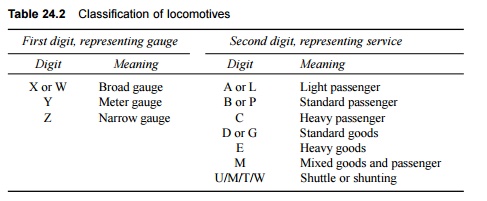
In the case of diesel or electric
locomotives, one additional alphabet-D, A, or C-is used to indicate diesel, ac
electric, or dc electric engines, respectively. Thus, YP indicates a steam
locomotive for MG for a standard passenger train. WAG indicates a broad gauge
ac electric locomotive used to haul a goods train. Table 24.3 enlists the
salient features of some of the typical locomotives in use on Indian Railways.
Table 24.3 Salient features of some
typical locomotives
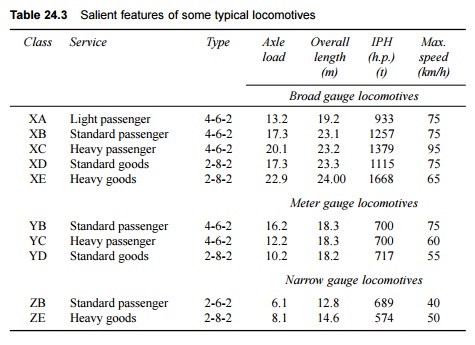
1 Steam Locomotive
Figure 24.1 shows the sketch of a typical steam locomotive
while the various parts of a steam locomotive are described in detail in the
following subsections.
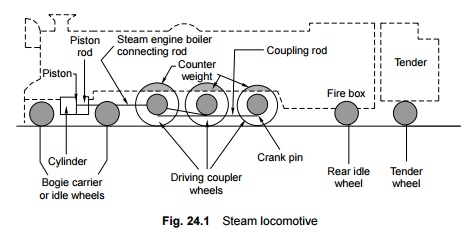
Boiler
A boiler consists of a fire box,
a barrel, and a smoke box. Coal is fired in the fire box, where water is
converted into steam. The smoke and gases from the fire box pass through the
smoke pipe and finally get discharged through the chimney. The chemical energy
of the fuel is thus converted into the heat energy of the steam.
Steam engine
The steam engine consists of a
cylinder, piston, and other moving parts. It converts the heat energy of the
steam into rotary energy in the following manner.
1. The steam
from the boiler is first admitted into a cylinder fitted with a valve. The
valve is operated mechanically.
2. Steam
enters into the cylinder on one side from behind a steam-tight piston that is
fitted inside the cylinder. The piston can move forward and backward.
3. The steam
exerts a force of several tonnes on the piston. This force is transmitted to a
crank pin fitted out of centre on each wheel (away from the centre of the
wheel) through rods and other connections. The linear motion of the piston is
converted into rotary motion and the wheel starts rotating.
Wheel and frame
The locomotive has idle as well
as loaded wheels. The frame is supported on the wheels; it carries the boiler
and also holds the steam engine and other parts of the locomotive.
Tender
A tender is provided behind the
locomotive to store fuel. The tender is a type of mini-wagon that is supported
on wheels and is coupled with the main locomotive.
General
Indian Railways has phased out all steam locomotives and no
steam locomotive is presently being manufactured by or used on the Railways.
2 Diesel Locomotives
The diesel locomotive (Fig. 24.2)
works on the principle of a diesel engine. It uses diesel oil as fuel and
combustion takes places inside a cylinder. The air inside the cylinder is
compressed, raising the temperature of the air. The fuel is injected inside the
cylinder, causing spontaneous combustion. The diesel engine mostly comprises of
four-stroke cycles consisting of suction, compression, ignition, and exhaust.
The energy thus generated is utilized for driving the locomotive.
The horse power generated in a
diesel locomotive is transmitted to its wheels in the following manner
(a) Mechanical
transmission in the case of conventional diesel locomotives
(b) Hydraulic
transmission in the case of diesel-hydraulic locomotives
(c) Electric
transmission in the case of diesel-electric locomotives.
Diesel-electric locomotives have
become quite popular because of economy in operation and high tractive effort
even at low speeds. All the standard main line BG and MG locomotives on Indian
Railways function via electric transmission. The different types of diesel
locomotives in use on Indian Railways are as follows:
Broad
gauge WBM1, WBM2, and WBM3
Meter
gauge YDM1, YDM2, and YDM3
Indian Railways has, however,
recently standardized WBM2 diesel locomotives for BG lines and YDM4 diesel
locomotives for MG lines. Both these locomotives are of the ALCO design and are
currently being manufactured in DLW Varanasi. The WDM2 locomotives have a
horsepower of 2600 and are capable of hauling 3600 t of train load at a speed
of 72 m/h on a level track. The maximum speed that can be achieved using this
locomotive is 120 km/h.
The latest series of locomotives
are the WDG2 locomotives for goods traffic and WDP1 and WDP2 locomotives for
passenger traffic. These locomotives have greater horsepower and superior
performance capabilities.
3 Electric Locomotives
In electric locomotives (Fig. 24.3), movement is brought about
by means of electric motors. These motors draw power from an overhead
distribution system through pantographs (joined frameworks conveying current to
an electric train from overhead wines) mounted on the locomotives. There are
different systems for feeding power to these locomotives, namely 1500-V dc,
750-V dc, 25-kV ac single-phase, and ac three-phase. The most economical way of
transmitting and distributing power is to directly transmit ac power at
industrial frequency, whereas the motors most suited for electric traction are
dc series motors. Indian Railways has locomotives that have the best of both
systems, i.e., locomotives with dc series motors that collect power at 25 kV ac
single-phase at an industrial frequency of 50 cycles. The voltage is stepped
down to a lower voltage by means of a transformer present inside the
locomotive, converted from 1500 V or 750 V ac to dc by means of silicon
rectifiers, and this power is then fed to the dc series motors inside the
electric locomotives. This system has been adopted in India since 1957 and is
based on the system adopted by French National Railways.

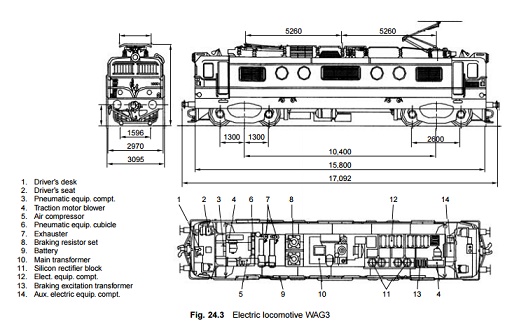
Earlier, Indian Railways had an
electric traction system that worked using 1500-V dc and 3000-V ac. The
electrification of a locomotive in India was first undertaken between 1925 and
1932 at 1500-V dc. This consisted of 304 route km on Central Railways from
Bombay VT to Igatpuri and Pune, 62 km on Western Railways between Churchgate
and Virar, and 32 km between Madras beach and Tambaram. These sections still
use a 1500-V dc system to power their locomotives. In addition, 142 route km
around Calcutta were electrified using a 3000-V dc system in 1954- 58, which
has subsequently been converted into a 25-kV ac system.
The details of the four different
types of electric locomotives in use on Indian Railways (IR) are given in Table
24.4.
Table 24.4 Details of electric
engines on IR

The WAM1, WAG1, WAG3, and WAG4
locomotives are based on European design whereas the WAM4, WAP1, WCM1, and WAG5
locomotives have been designed in India with a six wheel arrangement for its
bogies, which is similar to diesel WDM locomotives. Some of these locomotives
are capable of hauling the latest type of BOX-N wagons with air brake
arrangement.
It may be mentioned here that the
WAP1 is a passenger locomotive that has a vacuum as well as an air brake system
and is designed to run at speeds of up to 130 km/h. The Rajdhani Express on the
Delhi-Howrah route is hauled by such locomotives. The horsepower, weight, and
maximum service speed of different types of locomotives are given in Table
24.5.
Table 24.5 Horsepower, weight, and
service speed of various locomotives
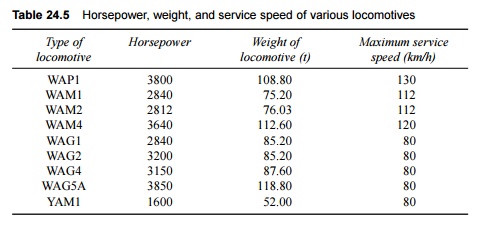
Related Topics